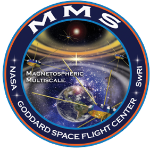We investigate reformation process of a rippled quasi-parallel shock with a 2-D hybrid simulation model. The simulation results show that at a rippled shock, incident particles behave differently and just can be partially reflected at some specific locations along the rippled shock front, and the reflected particles will form an ion beam that moves back to the upstream along the magnetic field. Then, the beam locally interacts with upstream waves, and the waves are enhanced and finally steepen into a new shock front. As the upstream incident plasma moves to the shock front, the new shock front will approach and merge with the old shock front. Such a process occurs only before these locations along the shock front, and after the merging of the new shock front and old shock front is finished, a relatively plane shock front is formed. Subsequently, a new rippled shock front is again generated due to its interaction with the upstream waves, and it will repeat the previous process. In this pattern, the shock reforms itself quasiperiodically, and at the same time, ripples can shift along the shock front. And, based on MMS observations the reformation of an oblique bow shock, which is very similar to a quasi-parallel shock, will also be introduced briefly in this talk.

 PDF version
PDF version
